Financial Reporting: IFRS, Stakeholders, and Performance Analysis
VerifiedAdded on 2020/06/06
|18
|4548
|201
Report
AI Summary
This report provides a comprehensive overview of financial reporting, beginning with an introduction to the conceptual and regulatory framework, emphasizing the importance of financial information to stakeholders. It identifies both internal and external stakeholders and details the significance of financial reports for an organization. The report includes the preparation and analysis of financial statements, specifically an income statement, for Rita plc. It delves into the interpretation of financial performance, differentiating between IAS and IFRS, and highlighting the advantages of IFRS. The report also provides a case study on Sainsbury's financial performance and concludes with a summary of the key concepts discussed. The report covers essential aspects of financial reporting, including the objectives of financial reporting, the regulatory framework, qualitative characteristics, and the role of stakeholders. It also contains a detailed analysis of Rita plc's financial performance through its income statement, showcasing the application of financial reporting principles.
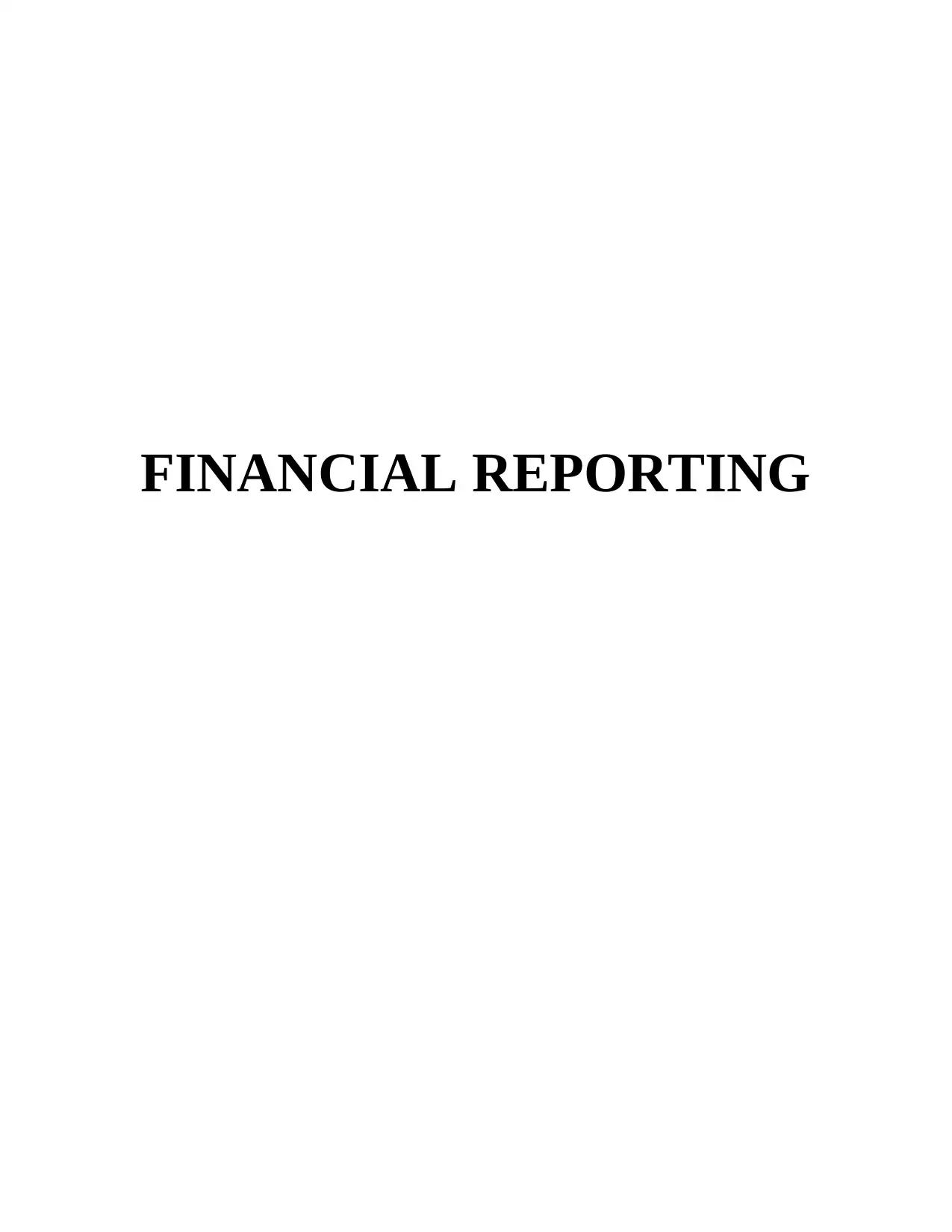
FINANCIAL REPORTING
Paraphrase This Document
Need a fresh take? Get an instant paraphrase of this document with our AI Paraphraser
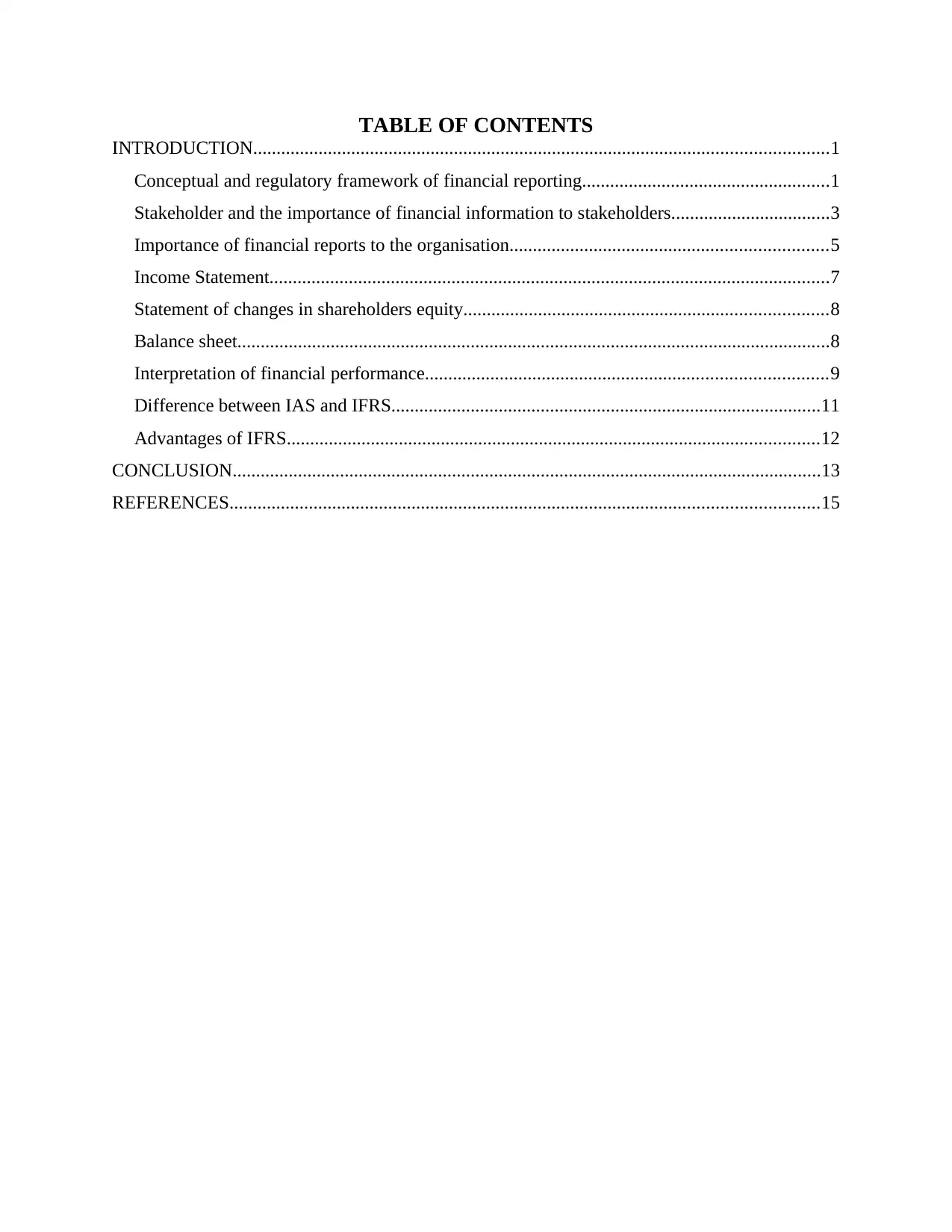
TABLE OF CONTENTS
INTRODUCTION...........................................................................................................................1
Conceptual and regulatory framework of financial reporting.....................................................1
Stakeholder and the importance of financial information to stakeholders..................................3
Importance of financial reports to the organisation....................................................................5
Income Statement........................................................................................................................7
Statement of changes in shareholders equity..............................................................................8
Balance sheet...............................................................................................................................8
Interpretation of financial performance......................................................................................9
Difference between IAS and IFRS............................................................................................11
Advantages of IFRS..................................................................................................................12
CONCLUSION..............................................................................................................................13
REFERENCES..............................................................................................................................15
INTRODUCTION...........................................................................................................................1
Conceptual and regulatory framework of financial reporting.....................................................1
Stakeholder and the importance of financial information to stakeholders..................................3
Importance of financial reports to the organisation....................................................................5
Income Statement........................................................................................................................7
Statement of changes in shareholders equity..............................................................................8
Balance sheet...............................................................................................................................8
Interpretation of financial performance......................................................................................9
Difference between IAS and IFRS............................................................................................11
Advantages of IFRS..................................................................................................................12
CONCLUSION..............................................................................................................................13
REFERENCES..............................................................................................................................15
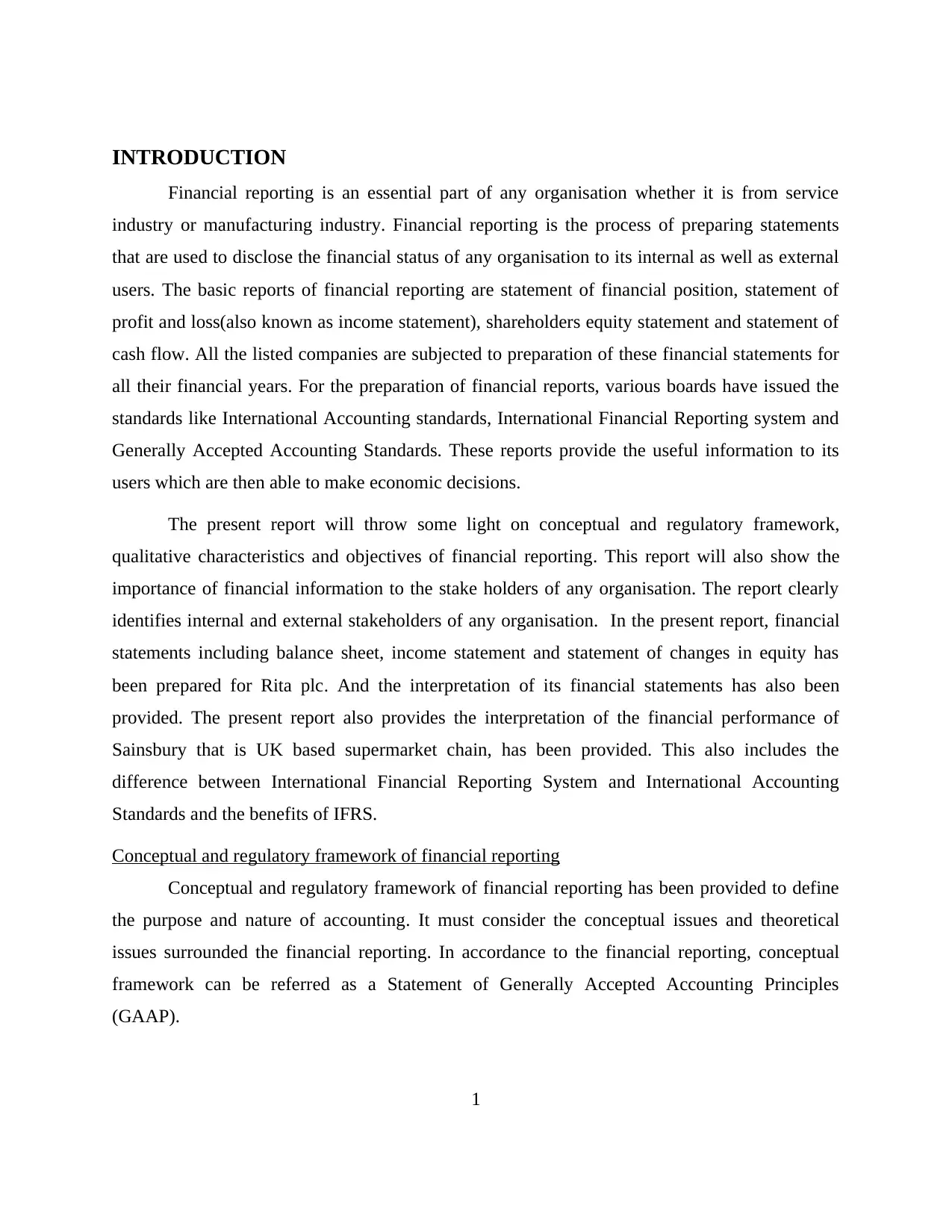
INTRODUCTION
Financial reporting is an essential part of any organisation whether it is from service
industry or manufacturing industry. Financial reporting is the process of preparing statements
that are used to disclose the financial status of any organisation to its internal as well as external
users. The basic reports of financial reporting are statement of financial position, statement of
profit and loss(also known as income statement), shareholders equity statement and statement of
cash flow. All the listed companies are subjected to preparation of these financial statements for
all their financial years. For the preparation of financial reports, various boards have issued the
standards like International Accounting standards, International Financial Reporting system and
Generally Accepted Accounting Standards. These reports provide the useful information to its
users which are then able to make economic decisions.
The present report will throw some light on conceptual and regulatory framework,
qualitative characteristics and objectives of financial reporting. This report will also show the
importance of financial information to the stake holders of any organisation. The report clearly
identifies internal and external stakeholders of any organisation. In the present report, financial
statements including balance sheet, income statement and statement of changes in equity has
been prepared for Rita plc. And the interpretation of its financial statements has also been
provided. The present report also provides the interpretation of the financial performance of
Sainsbury that is UK based supermarket chain, has been provided. This also includes the
difference between International Financial Reporting System and International Accounting
Standards and the benefits of IFRS.
Conceptual and regulatory framework of financial reporting
Conceptual and regulatory framework of financial reporting has been provided to define
the purpose and nature of accounting. It must consider the conceptual issues and theoretical
issues surrounded the financial reporting. In accordance to the financial reporting, conceptual
framework can be referred as a Statement of Generally Accepted Accounting Principles
(GAAP).
1
Financial reporting is an essential part of any organisation whether it is from service
industry or manufacturing industry. Financial reporting is the process of preparing statements
that are used to disclose the financial status of any organisation to its internal as well as external
users. The basic reports of financial reporting are statement of financial position, statement of
profit and loss(also known as income statement), shareholders equity statement and statement of
cash flow. All the listed companies are subjected to preparation of these financial statements for
all their financial years. For the preparation of financial reports, various boards have issued the
standards like International Accounting standards, International Financial Reporting system and
Generally Accepted Accounting Standards. These reports provide the useful information to its
users which are then able to make economic decisions.
The present report will throw some light on conceptual and regulatory framework,
qualitative characteristics and objectives of financial reporting. This report will also show the
importance of financial information to the stake holders of any organisation. The report clearly
identifies internal and external stakeholders of any organisation. In the present report, financial
statements including balance sheet, income statement and statement of changes in equity has
been prepared for Rita plc. And the interpretation of its financial statements has also been
provided. The present report also provides the interpretation of the financial performance of
Sainsbury that is UK based supermarket chain, has been provided. This also includes the
difference between International Financial Reporting System and International Accounting
Standards and the benefits of IFRS.
Conceptual and regulatory framework of financial reporting
Conceptual and regulatory framework of financial reporting has been provided to define
the purpose and nature of accounting. It must consider the conceptual issues and theoretical
issues surrounded the financial reporting. In accordance to the financial reporting, conceptual
framework can be referred as a Statement of Generally Accepted Accounting Principles
(GAAP).
1
⊘ This is a preview!⊘
Do you want full access?
Subscribe today to unlock all pages.

Trusted by 1+ million students worldwide
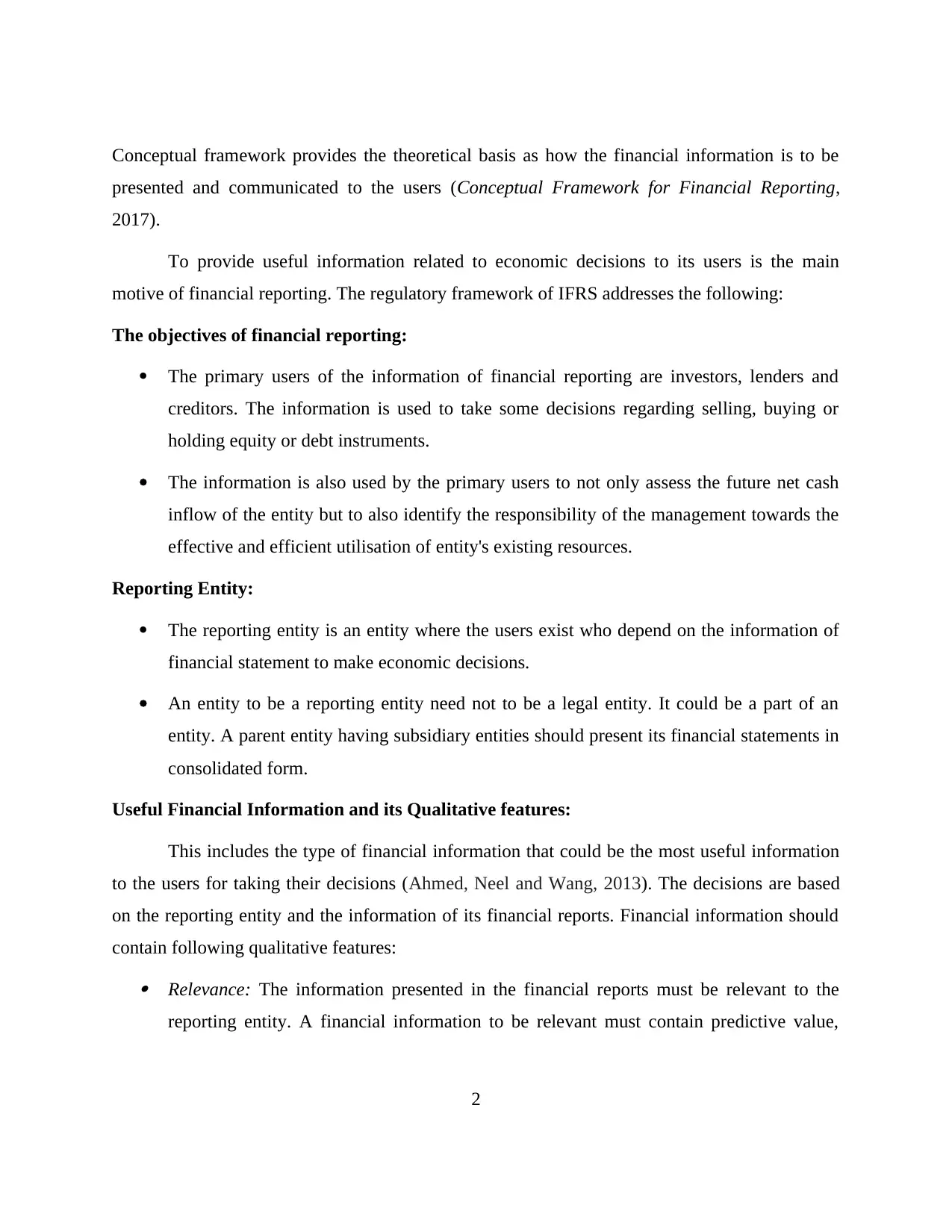
Conceptual framework provides the theoretical basis as how the financial information is to be
presented and communicated to the users (Conceptual Framework for Financial Reporting,
2017).
To provide useful information related to economic decisions to its users is the main
motive of financial reporting. The regulatory framework of IFRS addresses the following:
The objectives of financial reporting:
The primary users of the information of financial reporting are investors, lenders and
creditors. The information is used to take some decisions regarding selling, buying or
holding equity or debt instruments.
The information is also used by the primary users to not only assess the future net cash
inflow of the entity but to also identify the responsibility of the management towards the
effective and efficient utilisation of entity's existing resources.
Reporting Entity:
The reporting entity is an entity where the users exist who depend on the information of
financial statement to make economic decisions.
An entity to be a reporting entity need not to be a legal entity. It could be a part of an
entity. A parent entity having subsidiary entities should present its financial statements in
consolidated form.
Useful Financial Information and its Qualitative features:
This includes the type of financial information that could be the most useful information
to the users for taking their decisions (Ahmed, Neel and Wang, 2013). The decisions are based
on the reporting entity and the information of its financial reports. Financial information should
contain following qualitative features: Relevance: The information presented in the financial reports must be relevant to the
reporting entity. A financial information to be relevant must contain predictive value,
2
presented and communicated to the users (Conceptual Framework for Financial Reporting,
2017).
To provide useful information related to economic decisions to its users is the main
motive of financial reporting. The regulatory framework of IFRS addresses the following:
The objectives of financial reporting:
The primary users of the information of financial reporting are investors, lenders and
creditors. The information is used to take some decisions regarding selling, buying or
holding equity or debt instruments.
The information is also used by the primary users to not only assess the future net cash
inflow of the entity but to also identify the responsibility of the management towards the
effective and efficient utilisation of entity's existing resources.
Reporting Entity:
The reporting entity is an entity where the users exist who depend on the information of
financial statement to make economic decisions.
An entity to be a reporting entity need not to be a legal entity. It could be a part of an
entity. A parent entity having subsidiary entities should present its financial statements in
consolidated form.
Useful Financial Information and its Qualitative features:
This includes the type of financial information that could be the most useful information
to the users for taking their decisions (Ahmed, Neel and Wang, 2013). The decisions are based
on the reporting entity and the information of its financial reports. Financial information should
contain following qualitative features: Relevance: The information presented in the financial reports must be relevant to the
reporting entity. A financial information to be relevant must contain predictive value,
2
Paraphrase This Document
Need a fresh take? Get an instant paraphrase of this document with our AI Paraphraser
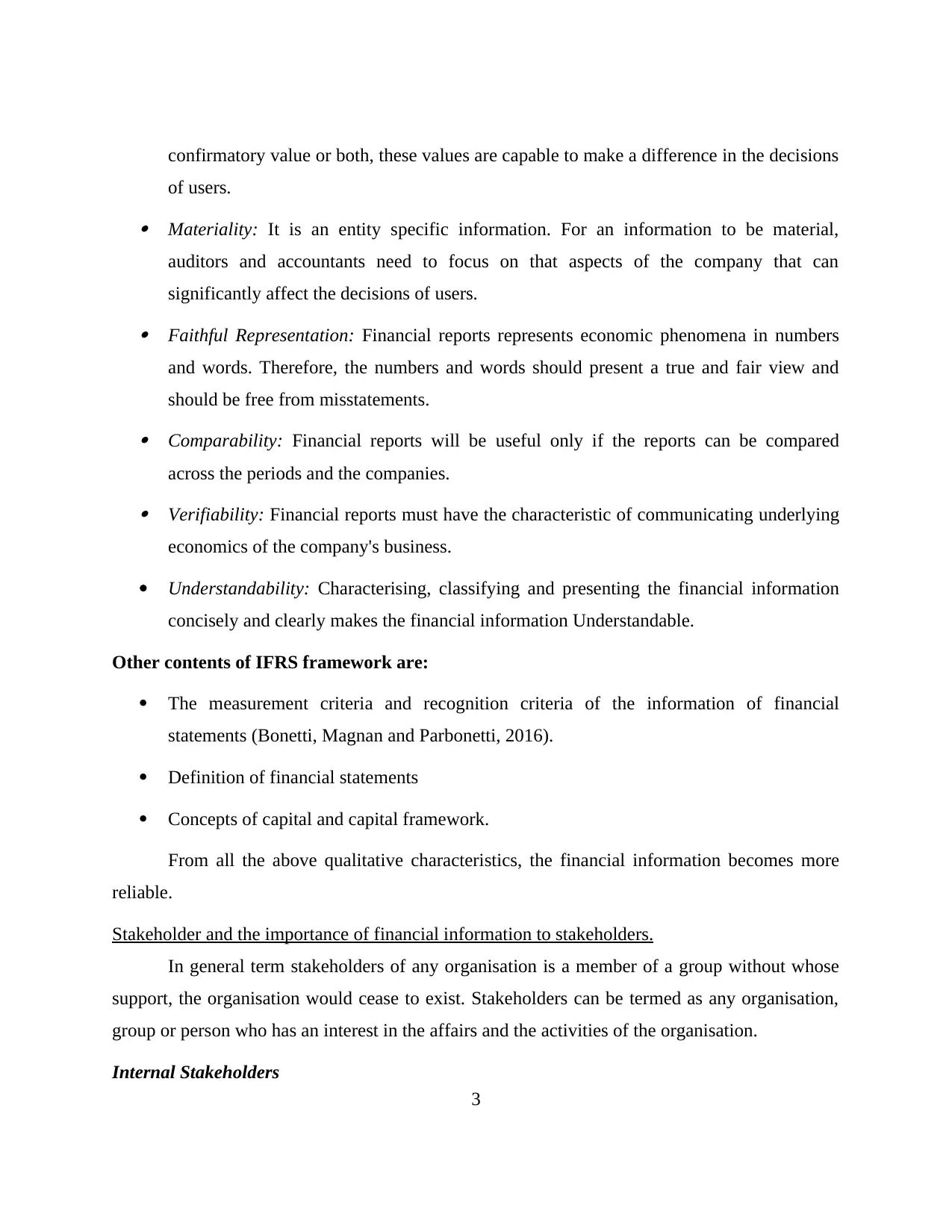
confirmatory value or both, these values are capable to make a difference in the decisions
of users. Materiality: It is an entity specific information. For an information to be material,
auditors and accountants need to focus on that aspects of the company that can
significantly affect the decisions of users. Faithful Representation: Financial reports represents economic phenomena in numbers
and words. Therefore, the numbers and words should present a true and fair view and
should be free from misstatements. Comparability: Financial reports will be useful only if the reports can be compared
across the periods and the companies. Verifiability: Financial reports must have the characteristic of communicating underlying
economics of the company's business.
Understandability: Characterising, classifying and presenting the financial information
concisely and clearly makes the financial information Understandable.
Other contents of IFRS framework are:
The measurement criteria and recognition criteria of the information of financial
statements (Bonetti, Magnan and Parbonetti, 2016).
Definition of financial statements
Concepts of capital and capital framework.
From all the above qualitative characteristics, the financial information becomes more
reliable.
Stakeholder and the importance of financial information to stakeholders.
In general term stakeholders of any organisation is a member of a group without whose
support, the organisation would cease to exist. Stakeholders can be termed as any organisation,
group or person who has an interest in the affairs and the activities of the organisation.
Internal Stakeholders
3
of users. Materiality: It is an entity specific information. For an information to be material,
auditors and accountants need to focus on that aspects of the company that can
significantly affect the decisions of users. Faithful Representation: Financial reports represents economic phenomena in numbers
and words. Therefore, the numbers and words should present a true and fair view and
should be free from misstatements. Comparability: Financial reports will be useful only if the reports can be compared
across the periods and the companies. Verifiability: Financial reports must have the characteristic of communicating underlying
economics of the company's business.
Understandability: Characterising, classifying and presenting the financial information
concisely and clearly makes the financial information Understandable.
Other contents of IFRS framework are:
The measurement criteria and recognition criteria of the information of financial
statements (Bonetti, Magnan and Parbonetti, 2016).
Definition of financial statements
Concepts of capital and capital framework.
From all the above qualitative characteristics, the financial information becomes more
reliable.
Stakeholder and the importance of financial information to stakeholders.
In general term stakeholders of any organisation is a member of a group without whose
support, the organisation would cease to exist. Stakeholders can be termed as any organisation,
group or person who has an interest in the affairs and the activities of the organisation.
Internal Stakeholders
3
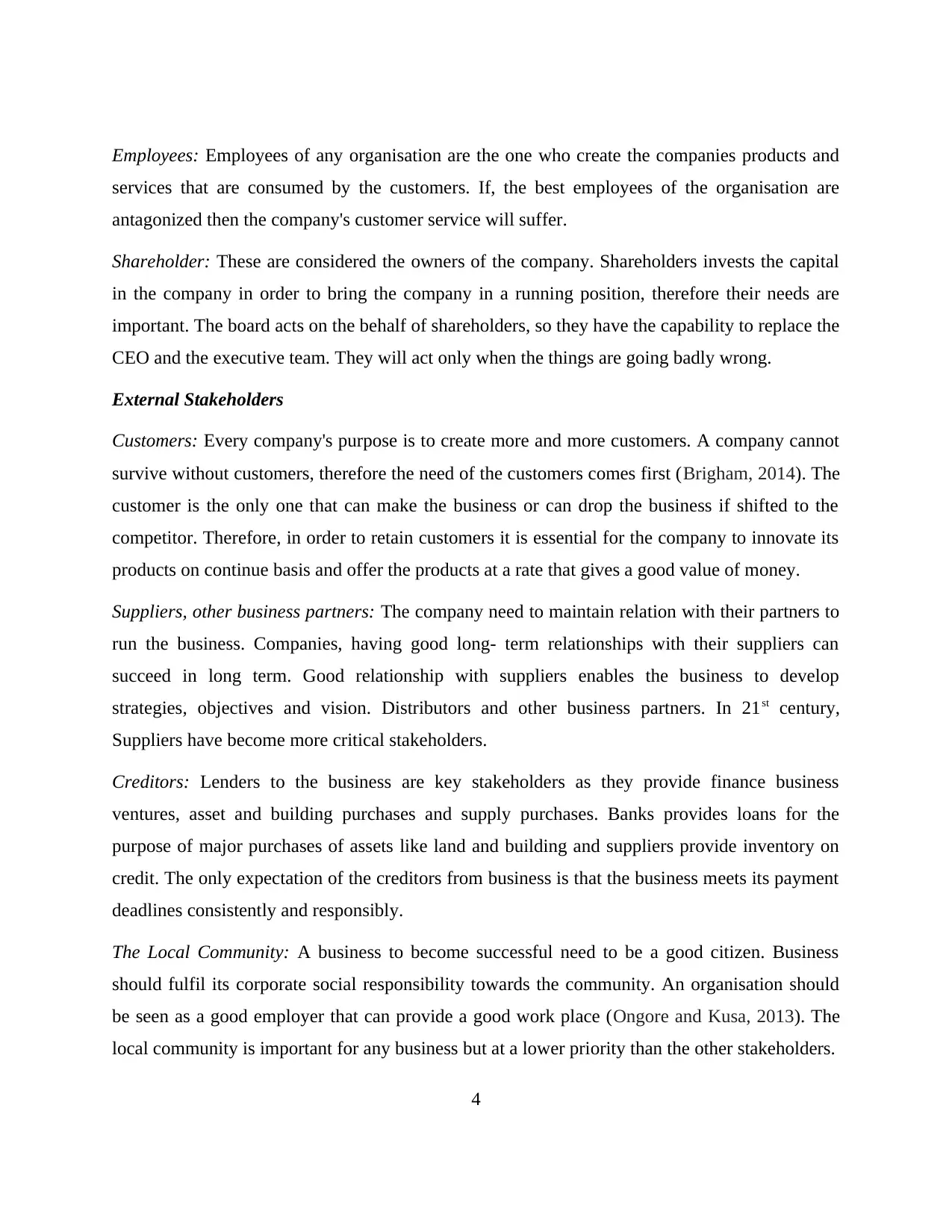
Employees: Employees of any organisation are the one who create the companies products and
services that are consumed by the customers. If, the best employees of the organisation are
antagonized then the company's customer service will suffer.
Shareholder: These are considered the owners of the company. Shareholders invests the capital
in the company in order to bring the company in a running position, therefore their needs are
important. The board acts on the behalf of shareholders, so they have the capability to replace the
CEO and the executive team. They will act only when the things are going badly wrong.
External Stakeholders
Customers: Every company's purpose is to create more and more customers. A company cannot
survive without customers, therefore the need of the customers comes first (Brigham, 2014). The
customer is the only one that can make the business or can drop the business if shifted to the
competitor. Therefore, in order to retain customers it is essential for the company to innovate its
products on continue basis and offer the products at a rate that gives a good value of money.
Suppliers, other business partners: The company need to maintain relation with their partners to
run the business. Companies, having good long- term relationships with their suppliers can
succeed in long term. Good relationship with suppliers enables the business to develop
strategies, objectives and vision. Distributors and other business partners. In 21st century,
Suppliers have become more critical stakeholders.
Creditors: Lenders to the business are key stakeholders as they provide finance business
ventures, asset and building purchases and supply purchases. Banks provides loans for the
purpose of major purchases of assets like land and building and suppliers provide inventory on
credit. The only expectation of the creditors from business is that the business meets its payment
deadlines consistently and responsibly.
The Local Community: A business to become successful need to be a good citizen. Business
should fulfil its corporate social responsibility towards the community. An organisation should
be seen as a good employer that can provide a good work place (Ongore and Kusa, 2013). The
local community is important for any business but at a lower priority than the other stakeholders.
4
services that are consumed by the customers. If, the best employees of the organisation are
antagonized then the company's customer service will suffer.
Shareholder: These are considered the owners of the company. Shareholders invests the capital
in the company in order to bring the company in a running position, therefore their needs are
important. The board acts on the behalf of shareholders, so they have the capability to replace the
CEO and the executive team. They will act only when the things are going badly wrong.
External Stakeholders
Customers: Every company's purpose is to create more and more customers. A company cannot
survive without customers, therefore the need of the customers comes first (Brigham, 2014). The
customer is the only one that can make the business or can drop the business if shifted to the
competitor. Therefore, in order to retain customers it is essential for the company to innovate its
products on continue basis and offer the products at a rate that gives a good value of money.
Suppliers, other business partners: The company need to maintain relation with their partners to
run the business. Companies, having good long- term relationships with their suppliers can
succeed in long term. Good relationship with suppliers enables the business to develop
strategies, objectives and vision. Distributors and other business partners. In 21st century,
Suppliers have become more critical stakeholders.
Creditors: Lenders to the business are key stakeholders as they provide finance business
ventures, asset and building purchases and supply purchases. Banks provides loans for the
purpose of major purchases of assets like land and building and suppliers provide inventory on
credit. The only expectation of the creditors from business is that the business meets its payment
deadlines consistently and responsibly.
The Local Community: A business to become successful need to be a good citizen. Business
should fulfil its corporate social responsibility towards the community. An organisation should
be seen as a good employer that can provide a good work place (Ongore and Kusa, 2013). The
local community is important for any business but at a lower priority than the other stakeholders.
4
⊘ This is a preview!⊘
Do you want full access?
Subscribe today to unlock all pages.

Trusted by 1+ million students worldwide
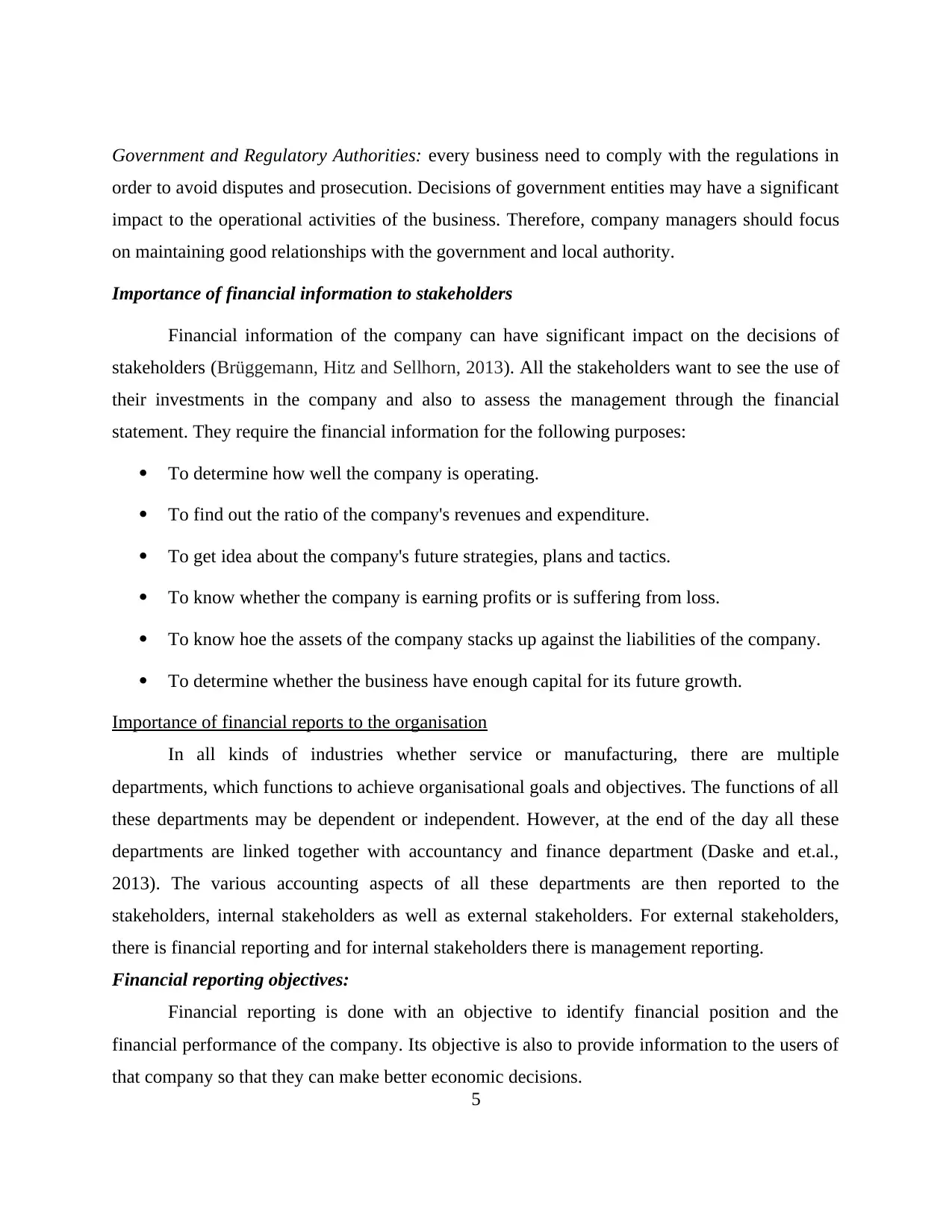
Government and Regulatory Authorities: every business need to comply with the regulations in
order to avoid disputes and prosecution. Decisions of government entities may have a significant
impact to the operational activities of the business. Therefore, company managers should focus
on maintaining good relationships with the government and local authority.
Importance of financial information to stakeholders
Financial information of the company can have significant impact on the decisions of
stakeholders (Brüggemann, Hitz and Sellhorn, 2013). All the stakeholders want to see the use of
their investments in the company and also to assess the management through the financial
statement. They require the financial information for the following purposes:
To determine how well the company is operating.
To find out the ratio of the company's revenues and expenditure.
To get idea about the company's future strategies, plans and tactics.
To know whether the company is earning profits or is suffering from loss.
To know hoe the assets of the company stacks up against the liabilities of the company.
To determine whether the business have enough capital for its future growth.
Importance of financial reports to the organisation
In all kinds of industries whether service or manufacturing, there are multiple
departments, which functions to achieve organisational goals and objectives. The functions of all
these departments may be dependent or independent. However, at the end of the day all these
departments are linked together with accountancy and finance department (Daske and et.al.,
2013). The various accounting aspects of all these departments are then reported to the
stakeholders, internal stakeholders as well as external stakeholders. For external stakeholders,
there is financial reporting and for internal stakeholders there is management reporting.
Financial reporting objectives:
Financial reporting is done with an objective to identify financial position and the
financial performance of the company. Its objective is also to provide information to the users of
that company so that they can make better economic decisions.
5
order to avoid disputes and prosecution. Decisions of government entities may have a significant
impact to the operational activities of the business. Therefore, company managers should focus
on maintaining good relationships with the government and local authority.
Importance of financial information to stakeholders
Financial information of the company can have significant impact on the decisions of
stakeholders (Brüggemann, Hitz and Sellhorn, 2013). All the stakeholders want to see the use of
their investments in the company and also to assess the management through the financial
statement. They require the financial information for the following purposes:
To determine how well the company is operating.
To find out the ratio of the company's revenues and expenditure.
To get idea about the company's future strategies, plans and tactics.
To know whether the company is earning profits or is suffering from loss.
To know hoe the assets of the company stacks up against the liabilities of the company.
To determine whether the business have enough capital for its future growth.
Importance of financial reports to the organisation
In all kinds of industries whether service or manufacturing, there are multiple
departments, which functions to achieve organisational goals and objectives. The functions of all
these departments may be dependent or independent. However, at the end of the day all these
departments are linked together with accountancy and finance department (Daske and et.al.,
2013). The various accounting aspects of all these departments are then reported to the
stakeholders, internal stakeholders as well as external stakeholders. For external stakeholders,
there is financial reporting and for internal stakeholders there is management reporting.
Financial reporting objectives:
Financial reporting is done with an objective to identify financial position and the
financial performance of the company. Its objective is also to provide information to the users of
that company so that they can make better economic decisions.
5
Paraphrase This Document
Need a fresh take? Get an instant paraphrase of this document with our AI Paraphraser
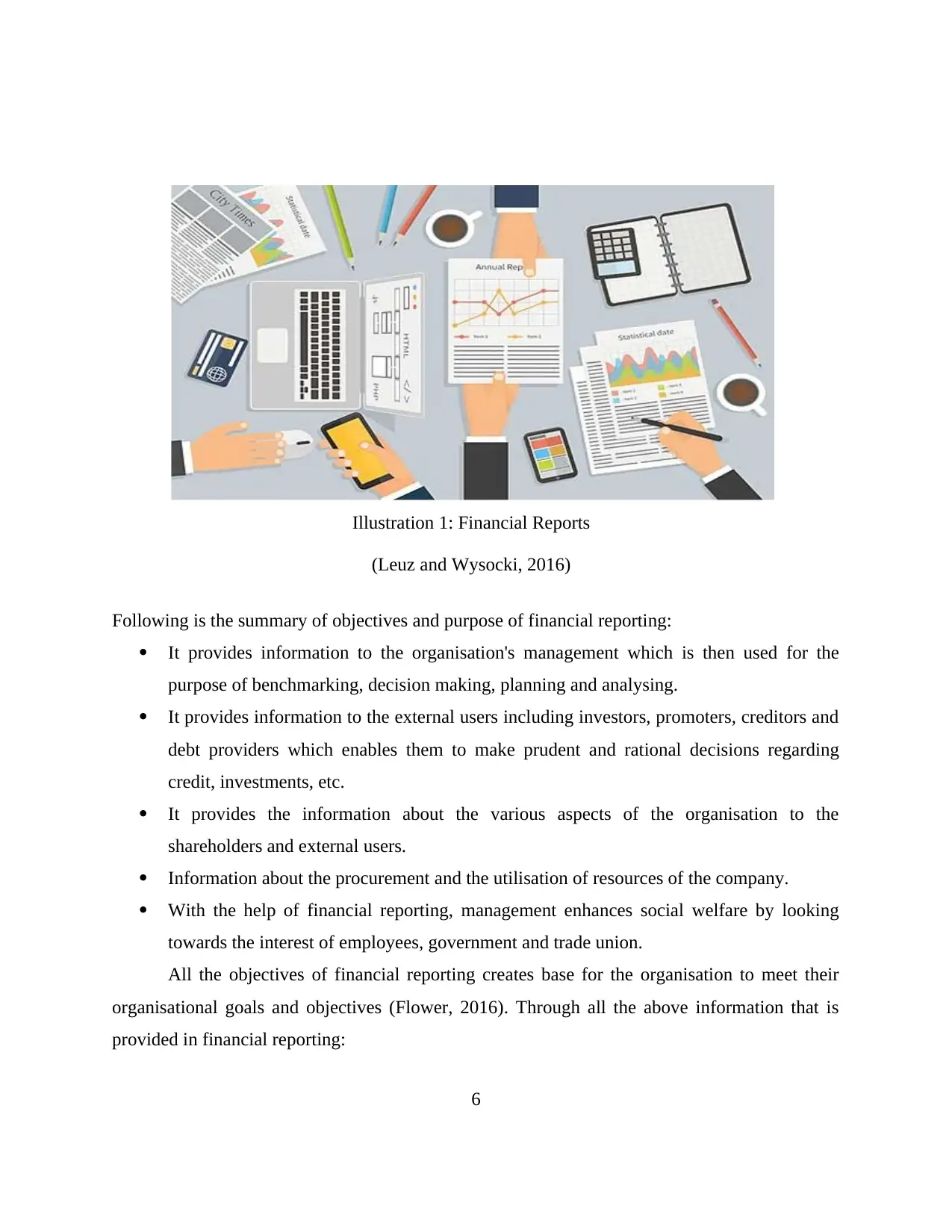
Illustration 1: Financial Reports
(Leuz and Wysocki, 2016)
Following is the summary of objectives and purpose of financial reporting:
It provides information to the organisation's management which is then used for the
purpose of benchmarking, decision making, planning and analysing.
It provides information to the external users including investors, promoters, creditors and
debt providers which enables them to make prudent and rational decisions regarding
credit, investments, etc.
It provides the information about the various aspects of the organisation to the
shareholders and external users.
Information about the procurement and the utilisation of resources of the company.
With the help of financial reporting, management enhances social welfare by looking
towards the interest of employees, government and trade union.
All the objectives of financial reporting creates base for the organisation to meet their
organisational goals and objectives (Flower, 2016). Through all the above information that is
provided in financial reporting:
6
(Leuz and Wysocki, 2016)
Following is the summary of objectives and purpose of financial reporting:
It provides information to the organisation's management which is then used for the
purpose of benchmarking, decision making, planning and analysing.
It provides information to the external users including investors, promoters, creditors and
debt providers which enables them to make prudent and rational decisions regarding
credit, investments, etc.
It provides the information about the various aspects of the organisation to the
shareholders and external users.
Information about the procurement and the utilisation of resources of the company.
With the help of financial reporting, management enhances social welfare by looking
towards the interest of employees, government and trade union.
All the objectives of financial reporting creates base for the organisation to meet their
organisational goals and objectives (Flower, 2016). Through all the above information that is
provided in financial reporting:
6
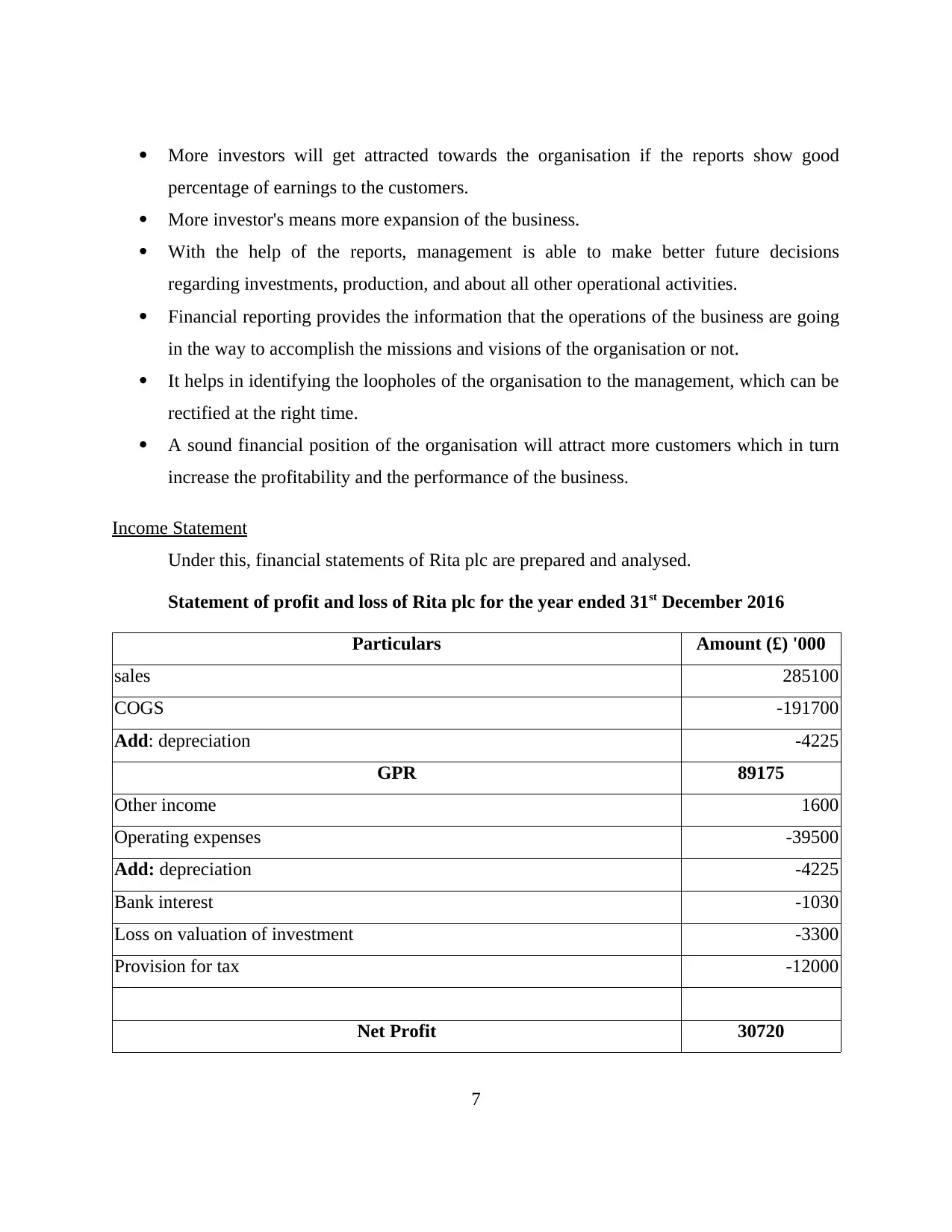
More investors will get attracted towards the organisation if the reports show good
percentage of earnings to the customers.
More investor's means more expansion of the business.
With the help of the reports, management is able to make better future decisions
regarding investments, production, and about all other operational activities.
Financial reporting provides the information that the operations of the business are going
in the way to accomplish the missions and visions of the organisation or not.
It helps in identifying the loopholes of the organisation to the management, which can be
rectified at the right time.
A sound financial position of the organisation will attract more customers which in turn
increase the profitability and the performance of the business.
Income Statement
Under this, financial statements of Rita plc are prepared and analysed.
Statement of profit and loss of Rita plc for the year ended 31st December 2016
Particulars Amount (£) '000
sales 285100
COGS -191700
Add: depreciation -4225
GPR 89175
Other income 1600
Operating expenses -39500
Add: depreciation -4225
Bank interest -1030
Loss on valuation of investment -3300
Provision for tax -12000
Net Profit 30720
7
percentage of earnings to the customers.
More investor's means more expansion of the business.
With the help of the reports, management is able to make better future decisions
regarding investments, production, and about all other operational activities.
Financial reporting provides the information that the operations of the business are going
in the way to accomplish the missions and visions of the organisation or not.
It helps in identifying the loopholes of the organisation to the management, which can be
rectified at the right time.
A sound financial position of the organisation will attract more customers which in turn
increase the profitability and the performance of the business.
Income Statement
Under this, financial statements of Rita plc are prepared and analysed.
Statement of profit and loss of Rita plc for the year ended 31st December 2016
Particulars Amount (£) '000
sales 285100
COGS -191700
Add: depreciation -4225
GPR 89175
Other income 1600
Operating expenses -39500
Add: depreciation -4225
Bank interest -1030
Loss on valuation of investment -3300
Provision for tax -12000
Net Profit 30720
7
⊘ This is a preview!⊘
Do you want full access?
Subscribe today to unlock all pages.

Trusted by 1+ million students worldwide

Working notes:
Calculation of distribution of depreciation amount
Particulars Details (£) '000 Amount (£) '000
Depreciation on Land and Property 84000/16 5250
Depreciation on plant and equipment
(48000-22400) *0.125
3200
Total 8450
Cost of sales 8450*50% 4225
Operating expenses 8450*50% 4225
It is been assumed that the company is holding damaged goods, and no rectification
charges have been applied.
Like Income statement, cash flow is also a financial report. It is similar to income
statement but the only difference between two of them is that the profit and loss statement also
takes some non- cash items in account such as depreciation. Therefore, income statement of any
company also provides information about expenses and incomes which are of non- cash nature.
However, the cash flow statement is prepared to determine the short-term liquidity position of
the company.
Statement of changes in shareholders equity
Statement of changes in equity of Rita plc at the year ended 31st December 2016
Particulars Share Capital (£) '000 Retained Earnings (£) '000
opening balance nil 23300
net income 30720
dividends -6670
issue of share capital 40000
Total 40000 47350
8
Calculation of distribution of depreciation amount
Particulars Details (£) '000 Amount (£) '000
Depreciation on Land and Property 84000/16 5250
Depreciation on plant and equipment
(48000-22400) *0.125
3200
Total 8450
Cost of sales 8450*50% 4225
Operating expenses 8450*50% 4225
It is been assumed that the company is holding damaged goods, and no rectification
charges have been applied.
Like Income statement, cash flow is also a financial report. It is similar to income
statement but the only difference between two of them is that the profit and loss statement also
takes some non- cash items in account such as depreciation. Therefore, income statement of any
company also provides information about expenses and incomes which are of non- cash nature.
However, the cash flow statement is prepared to determine the short-term liquidity position of
the company.
Statement of changes in shareholders equity
Statement of changes in equity of Rita plc at the year ended 31st December 2016
Particulars Share Capital (£) '000 Retained Earnings (£) '000
opening balance nil 23300
net income 30720
dividends -6670
issue of share capital 40000
Total 40000 47350
8
Paraphrase This Document
Need a fresh take? Get an instant paraphrase of this document with our AI Paraphraser
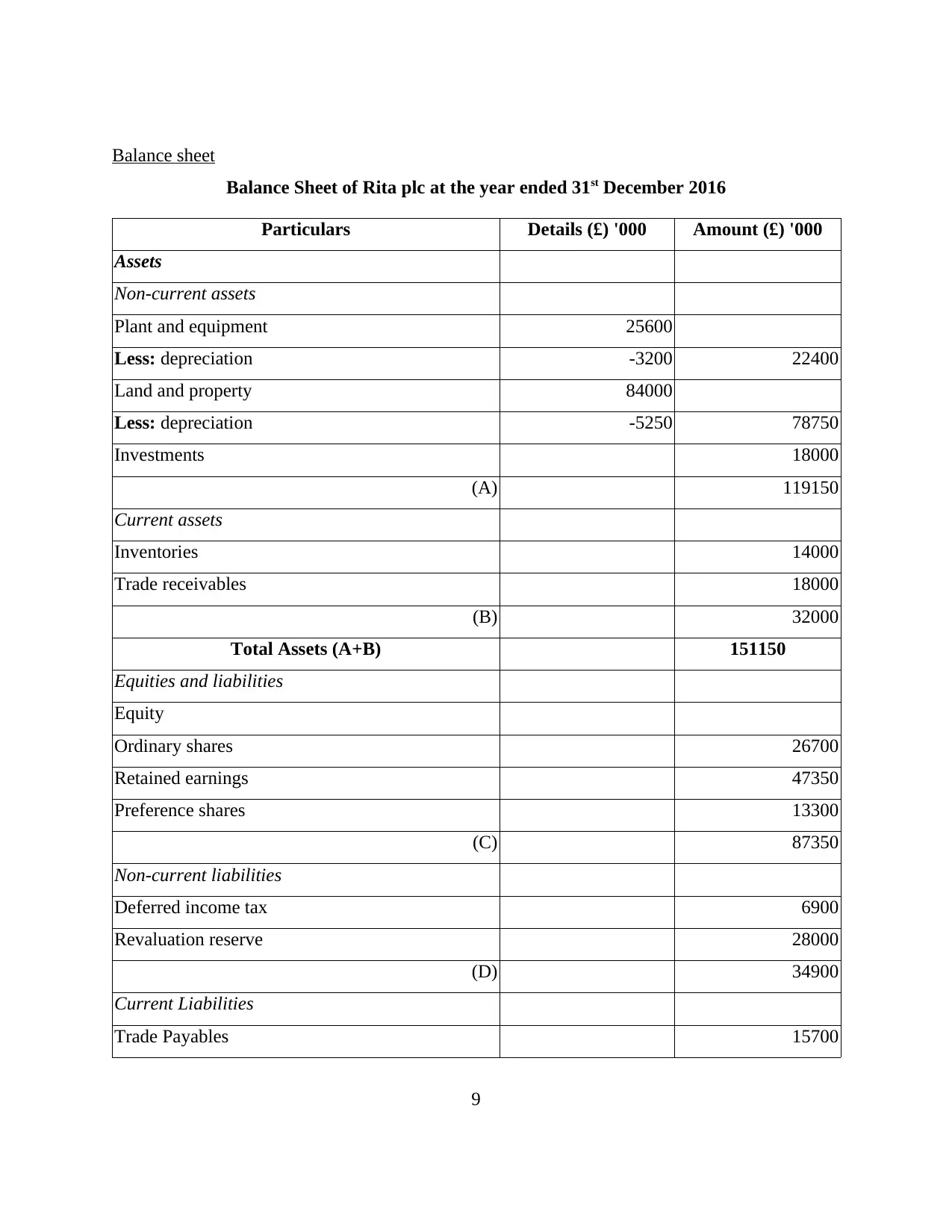
Balance sheet
Balance Sheet of Rita plc at the year ended 31st December 2016
Particulars Details (£) '000 Amount (£) '000
Assets
Non-current assets
Plant and equipment 25600
Less: depreciation -3200 22400
Land and property 84000
Less: depreciation -5250 78750
Investments 18000
(A) 119150
Current assets
Inventories 14000
Trade receivables 18000
(B) 32000
Total Assets (A+B) 151150
Equities and liabilities
Equity
Ordinary shares 26700
Retained earnings 47350
Preference shares 13300
(C) 87350
Non-current liabilities
Deferred income tax 6900
Revaluation reserve 28000
(D) 34900
Current Liabilities
Trade Payables 15700
9
Balance Sheet of Rita plc at the year ended 31st December 2016
Particulars Details (£) '000 Amount (£) '000
Assets
Non-current assets
Plant and equipment 25600
Less: depreciation -3200 22400
Land and property 84000
Less: depreciation -5250 78750
Investments 18000
(A) 119150
Current assets
Inventories 14000
Trade receivables 18000
(B) 32000
Total Assets (A+B) 151150
Equities and liabilities
Equity
Ordinary shares 26700
Retained earnings 47350
Preference shares 13300
(C) 87350
Non-current liabilities
Deferred income tax 6900
Revaluation reserve 28000
(D) 34900
Current Liabilities
Trade Payables 15700
9
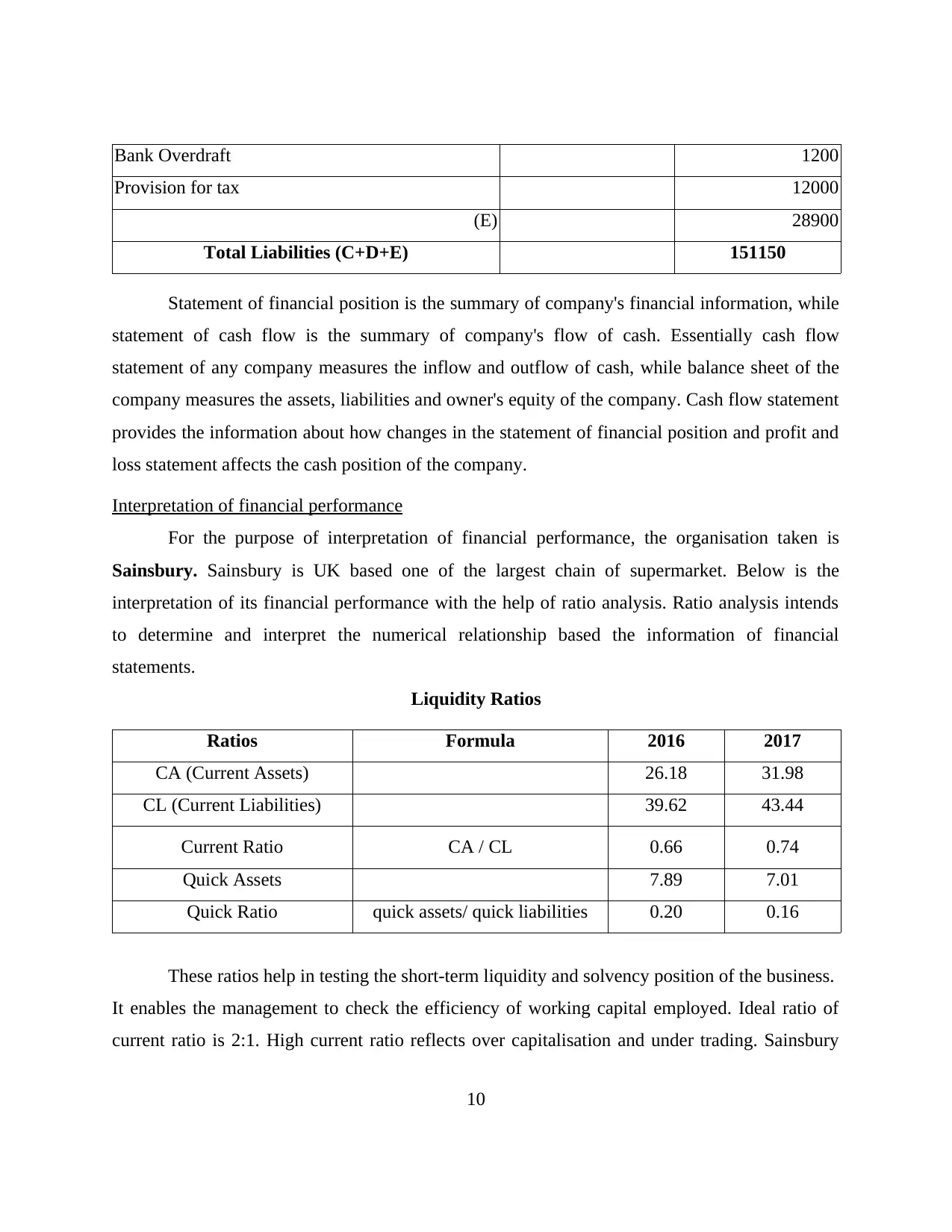
Bank Overdraft 1200
Provision for tax 12000
(E) 28900
Total Liabilities (C+D+E) 151150
Statement of financial position is the summary of company's financial information, while
statement of cash flow is the summary of company's flow of cash. Essentially cash flow
statement of any company measures the inflow and outflow of cash, while balance sheet of the
company measures the assets, liabilities and owner's equity of the company. Cash flow statement
provides the information about how changes in the statement of financial position and profit and
loss statement affects the cash position of the company.
Interpretation of financial performance
For the purpose of interpretation of financial performance, the organisation taken is
Sainsbury. Sainsbury is UK based one of the largest chain of supermarket. Below is the
interpretation of its financial performance with the help of ratio analysis. Ratio analysis intends
to determine and interpret the numerical relationship based the information of financial
statements.
Liquidity Ratios
Ratios Formula 2016 2017
CA (Current Assets) 26.18 31.98
CL (Current Liabilities) 39.62 43.44
Current Ratio CA / CL 0.66 0.74
Quick Assets 7.89 7.01
Quick Ratio quick assets/ quick liabilities 0.20 0.16
These ratios help in testing the short-term liquidity and solvency position of the business.
It enables the management to check the efficiency of working capital employed. Ideal ratio of
current ratio is 2:1. High current ratio reflects over capitalisation and under trading. Sainsbury
10
Provision for tax 12000
(E) 28900
Total Liabilities (C+D+E) 151150
Statement of financial position is the summary of company's financial information, while
statement of cash flow is the summary of company's flow of cash. Essentially cash flow
statement of any company measures the inflow and outflow of cash, while balance sheet of the
company measures the assets, liabilities and owner's equity of the company. Cash flow statement
provides the information about how changes in the statement of financial position and profit and
loss statement affects the cash position of the company.
Interpretation of financial performance
For the purpose of interpretation of financial performance, the organisation taken is
Sainsbury. Sainsbury is UK based one of the largest chain of supermarket. Below is the
interpretation of its financial performance with the help of ratio analysis. Ratio analysis intends
to determine and interpret the numerical relationship based the information of financial
statements.
Liquidity Ratios
Ratios Formula 2016 2017
CA (Current Assets) 26.18 31.98
CL (Current Liabilities) 39.62 43.44
Current Ratio CA / CL 0.66 0.74
Quick Assets 7.89 7.01
Quick Ratio quick assets/ quick liabilities 0.20 0.16
These ratios help in testing the short-term liquidity and solvency position of the business.
It enables the management to check the efficiency of working capital employed. Ideal ratio of
current ratio is 2:1. High current ratio reflects over capitalisation and under trading. Sainsbury
10
⊘ This is a preview!⊘
Do you want full access?
Subscribe today to unlock all pages.

Trusted by 1+ million students worldwide
1 out of 18
Related Documents
Your All-in-One AI-Powered Toolkit for Academic Success.
+13062052269
info@desklib.com
Available 24*7 on WhatsApp / Email
![[object Object]](/_next/static/media/star-bottom.7253800d.svg)
Unlock your academic potential
Copyright © 2020–2025 A2Z Services. All Rights Reserved. Developed and managed by ZUCOL.





